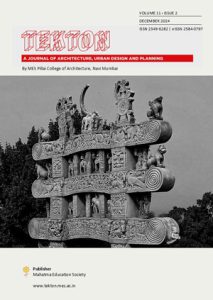Walkable Cities: Advocacy and Engagement
Rishi Aggarwal, Vedant Mhatre, Aishwarya Tatke
Tekton
Volume 11, Issue 2, December 2024
pp. 84-92
 Rishi Aggarwal is the founder and convener of Walking Project, initiated in 2012. Rishi hasbeen involved with Mumbai’s environmental, civic and governance issues over 25 years. During this period, he has been involved with saving large urban greens like mangroves and Aarey, waste management and the cities transport policy and planning. In 2016 he founded Mumbai Sustainability Centre. Last year he released his second book – “Saving Aarey – the undoing of an environmental campaign”.
Rishi Aggarwal is the founder and convener of Walking Project, initiated in 2012. Rishi hasbeen involved with Mumbai’s environmental, civic and governance issues over 25 years. During this period, he has been involved with saving large urban greens like mangroves and Aarey, waste management and the cities transport policy and planning. In 2016 he founded Mumbai Sustainability Centre. Last year he released his second book – “Saving Aarey – the undoing of an environmental campaign”.
 Vedant Mhatre is an electronics engineer; he is the co-founder and convener of Walking Project. He has extensive experience in civic activism, with interests centered on urbanism and public transportation. He is deeply passionate about fostering Mumbai’s growth and addressing the intricate challenges it presents. Over the years, he has effectively utilized media and digital platforms to advance his activism in both personal and professional capacities.
Vedant Mhatre is an electronics engineer; he is the co-founder and convener of Walking Project. He has extensive experience in civic activism, with interests centered on urbanism and public transportation. He is deeply passionate about fostering Mumbai’s growth and addressing the intricate challenges it presents. Over the years, he has effectively utilized media and digital platforms to advance his activism in both personal and professional capacities.
 Aishwarya Tatke is an architect interested in the interaction of people with the built and unbuilt spaces in the environment. She is keen on analysing the design of urban spaces that shape our daily experiences; influencing how we navigate, interact, and connect with our environment.
Aishwarya Tatke is an architect interested in the interaction of people with the built and unbuilt spaces in the environment. She is keen on analysing the design of urban spaces that shape our daily experiences; influencing how we navigate, interact, and connect with our environment.
info@walkingproject.org
@walkingprojectindia
In this ‘Practice Essay’, we invite ‘Walking Project’- an organization, a program, founded by Rishi Aggarwal which advocates for walking friendly Indian cities. It works closely with the community and government to advocate about pedestrian infrastructure on our roads and streets. Rishi and his team members write about their objectives and various tasks undertaken by them in the area of community awareness and collaborations with civic authorities about walkability and improving walking infrastructure in Mumbai.
Introduction
There is a crisis of walkability in Indian cities currently. The most basic form of mobility which also defines us as a species finds little respect or attention to detail on our roads and streets used by millions of citizens on a daily basis. And the crisis is not being addressed with the urgency that it deserves.
Walking is a significant component of mobility in our cities and especially in the Mumbai Metropolitan Region which houses nine municipal corporations besides towns and villages. More than 30 million people reside in the region and public transport is a prominent means of transport in the entire region.
Why Walkability?
We call walkability the everything agenda. A large number of developmental and environmental agendas all dovetail into this one agenda of making our cities walking friendly. If we pay close attention to providing high quality pedestrian infrastructure on our roads and streets then we immediately impact issues like road safety, gender, senior citizens, public health, climate action, heat stress, traffic congestion and much more.
For example, in the recent budget 2025-26 presented by the Brihanmumbai Municipal Corporation (BMC), in the gender budget there is a line, “Provision for Safe Environment for Children & Teachers to access the school in Clutter free footpath.” What this tells us as an advocacy organization is that the budget should not function in silos but as a cohesive whole. The BMC and its various departments should be aware of each other’s goals and budgets and be both willing and able to collaborate to achieve the desired results. Additionally, the multi-dimensional nature of each issue needs to be realised.
Gender issues are not just about girls’ education or domestic abuse. A great public transport system and safe, walkable streets can play a crucial role in the economic and social empowerment of women, making mobility a gender issue as well.
Research shows that physical mobility is linked to social mobility, and improving mobility for economically disadvantaged women in this city would significantly increase their opportunities for a better life. Statistics indicate that the vast majority of them rely on walking.
In this context, improving local mobility would mean developing pedestrian infrastructure that enables them to travel longer distances and access more potential employers on foot. This could include wider footpaths to accommodate higher pedestrian flow or better continuity in footpath design to reduce the physical effort required to navigate broken pathways and enhance safety.
By simply addressing these two factors, we can positively impact economic well-being, safety, gender equity, and more—ultimately, greatly enhancing the mobility of these groups in the long term.
(contd…)


